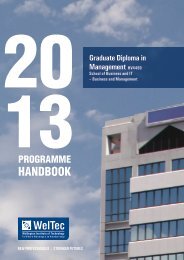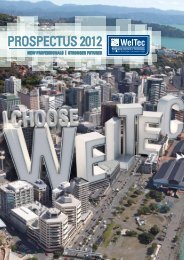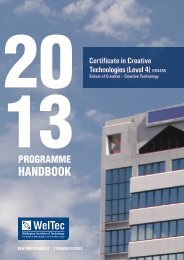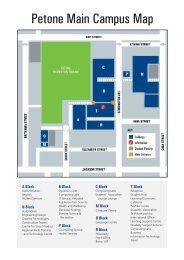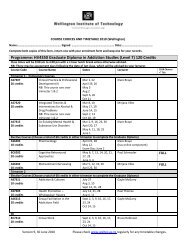Annual Report 2009 (PDF 2 MB) - Wellington Institute of Technology
Annual Report 2009 (PDF 2 MB) - Wellington Institute of Technology
Annual Report 2009 (PDF 2 MB) - Wellington Institute of Technology
- No tags were found...
Create successful ePaper yourself
Turn your PDF publications into a flip-book with our unique Google optimized e-Paper software.
DepreciationDepreciation has been provided on all property, plant and equipment, excluding land. Depreciation is calculated ona straight-line basis, at rates that expense the assets’ cost (or valuation) to their estimated residual values over theiruseful life.The useful life <strong>of</strong> each class <strong>of</strong> asset is as follows:FINANCIAL STATEMENTSBuildings- Shell 10 - 50 years- Services 10 - 25 years- Fit-out 10 - 15 yearsLeasehold improvements 2 - 15 years, based on lease renewal datesEquipment3 - 30 yearsMotor vehicles5 yearsFurniture and fittings 5 yearsLibrary collection5 yearsHardware3 yearsProvisionsProvisions are recognised when: a present obligation (legal or constructive) arises as a result <strong>of</strong> a past event; it isprobable that an outflow <strong>of</strong> resources embodying economic benefits will be required to settle the obligation; and areliable estimate can be made <strong>of</strong> the amount <strong>of</strong> the obligation.If the effect <strong>of</strong> the time value <strong>of</strong> money is material, provisions are determined by discounting the expected future cashflows at a pre-tax rate that reflects current market assessments <strong>of</strong> the time value <strong>of</strong> money and, where appropriate,the risks specific to the liability.Provisions are reviewed at each balance date, and adjusted to reflect the current best estimate. When it is no longerprobable that an outflow <strong>of</strong> resources embodying economic benefits will be required to settle the obligation, theprovision shall be reversed.Where discounting is used, the increase in the provision due to the passage <strong>of</strong> time is recognised as a finance cost.ReceivablesTrade receivables, student receivables and other receivables are recorded at cost less provision made foruncollectible balances.Reserves<strong>Wellington</strong> <strong>Institute</strong> <strong>of</strong> <strong>Technology</strong> has asset revaluation reserves which have been generated by the revaluation <strong>of</strong>equipment, land and buildings, as outlined in Property, Plant and Equipment above.RevenueRevenue is recognised to the extent that it is probable that the economic benefits will flow to <strong>Wellington</strong> <strong>Institute</strong><strong>of</strong> <strong>Technology</strong> and the revenue can be reliably measured. The following specific criteria must also be met beforerevenue is recognised:Government grantsGovernment grants are recognised when eligibility to receive the grant has been established. For StudentComponent Funding, entitlement is established upon the withdrawal period for an individual’s course <strong>of</strong> study havingpassed. For project-based grants, entitlement is established upon the completion <strong>of</strong> agreed milestones. Where fundshave been received but not earned at balance date, an Income in Advance liability is recognised.Student tuition feesRevenue from student tuition fees is recognised in the income statement on entitlement.32WELLINGTON INSTITUTE OF TECHNOLOGY | <strong>2009</strong> ANNUAL REPORT



